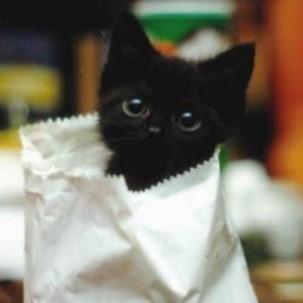
Many people assume that all animals communicate to humans the same way that they communicate to each other. But that is not true. Cats will communicate with other cats using body language and scent - this is their language. At times, they will include verbal communication but that is mostly for humans. If you don’t know what the clues are then their cues can bypass you. It is subtle, but once you can learn to read their more common cues, then you will have a happier relationship.
There are at least 19 different types of "miaow" which differ in pitch, rhythm, volume, tone, pronunciation and the situations in which they are used. The purr may be used as a sign of contentment, self-reassurance or an invitation for close contact. Injured or sick cats (and even dying cats) may purr because the sound frequency has been shown to soothe the cat and to promote healing. The "miaow" and purr are just two of at least thirteen different categories of sound made by cats: caterwaul, chatter, chirrup (chirp), cough-bark (rare in pet cats), growl, hiss (with or without spit). meow, mew (of kittens), purr, scream, squawk, yowl and unique sounds. The number of sounds a cat makes depends on how much the cat communicates with (a) other cats and (b) other non-cats e.g. humans.

Cats which communicate with humans a lot have a wider spoken vocabulary because they learn that humans understand sounds but cannot easily understand feline body language. Cats learn which sounds bring the desired response from their owners (staff?).
Housecats develop a wide variety of sounds to alert humans to their needs and intentions. Cats work out which sounds elicit suitable responses from humans (positive feedback) and learn to make those sounds in order to achieve a particular aim e.g. for a door to be opened. Many are variations on mother/kitten meow or chirp sounds which the cat has adapted in order to "speak" to non-cats. This is quite logical since the housecat remains dependent on humans. Others are adult sounds such as the caterwaul (used in a sexual or territorial context) or the cough-bark (a fear/anger sound usually accompanied by a front paw stamp).
Most cats tend not to vocalize with strangers unless the stranger approaches them. If the cat feels fearful s/he may hiss or growl and thrash its tail (agitation) to warn the stranger not to approach any closer. If friendly it will meow or purr and its tail will stick upwards (greeting) inviting attention, or possibly begging for food. Stray cats living around restaurants learn to beg appealingly to diners.
Cats also learn to communicate with other household animals e.g. dogs. They are less likely to vocalize because dogs can interpret scent signals and can learn some feline body language. Sometimes the cat must reinforce its unspoken message with a hiss if the other animals ignores or fails to understand body language.
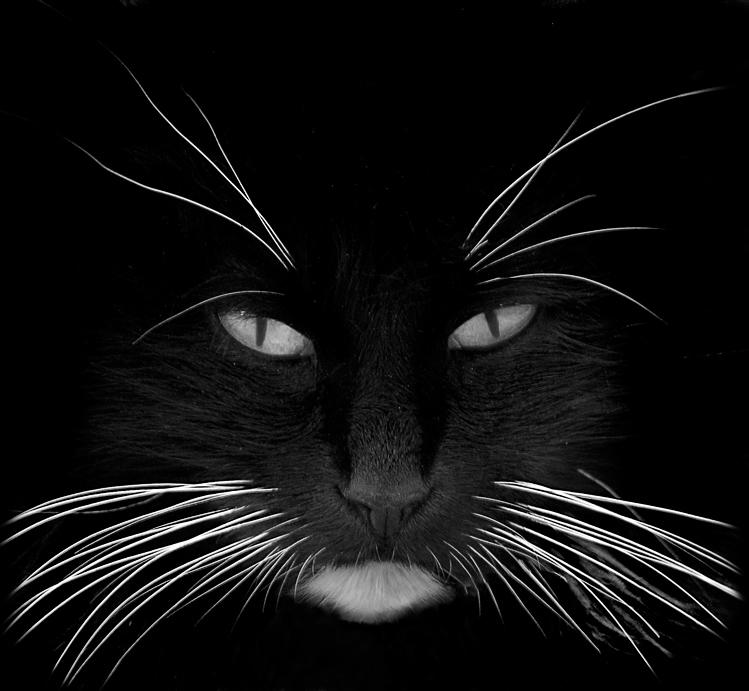
Feral cats rely more on their native body language. They don't need so many variations of "meow". They use all the "major sounds" e.g. yowl, growl, etc but they rely much more on non-verbal communication to convey meaning - posture, gesture, facial expression, tail position, whisker position, ear position, scent-marking - with vocalization often being a last resort. Feral cats with little or no contact with humans don't learn so much "spoken" language as do housecats. They have no need to learn a vocalized "second language" because they are communicating with native speakers of "cat body language".
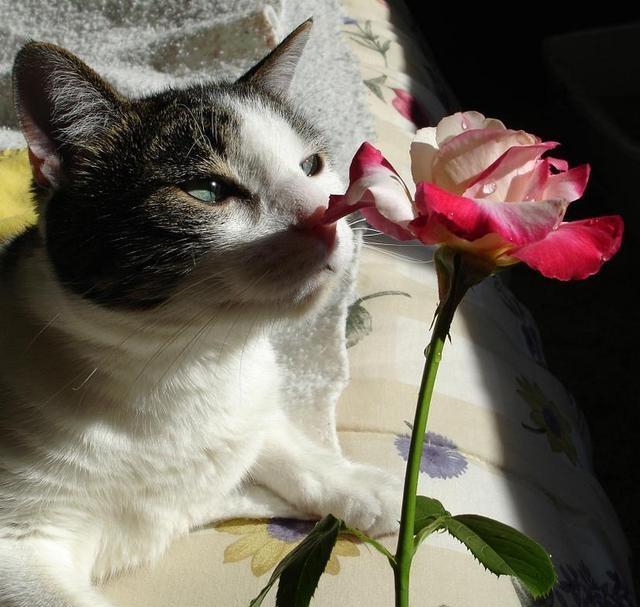
The first language a kitten learns is that of smell. It is blind, deaf and defenseless but it has well-developed senses of smell and touch (including warmth detection) to guide it to the mother cat's nipple. A kitten recognizes its own scent on the nipple and aims for the same nipple each feeding time. The mother identifies her kittens by their individual scent and by her own scent on them. This then is the first form of communication the kitten learns. Scent will play an important role all through the cat's life.
Cats have scent glands on the chin, lips (in the corners), temples and at the base of the tail. Each cat has its own scent signature. When it washes, a cat transfers its scent from these glands to its fur. This scent is then transferred to objects the cat rubs against - a couch, plants, a fence or a person's legs.
They use this scent to mark areas and objects around them, other cats, humans and other animals in the household. A new cat must literally rub up to superior members of the group to mix their scents before becoming an accepted member of the group. When a cat scratches, it leaves both a visual marker and a scent marker from its paw-pads. Scent is so important that blind cats can navigate around their indoor territories using a combination of memory and scent trails.
Cats that are familiar and friendly with each other often have a greeting ritual. They rub their head, side and tail against the other cat or person to exchange odours. They hold their tail straight up so that the other cat can sniff the anal glands. When stroked, cats raise their butts even higher (almost standing on tiptoe) to invite you to sniff their anal glands!
Male cats can spray urine to mark their territories and to advertise their sexual status. Neutered and unneutered cats of both sexes can also spray and Siamese cats (either sex, neutered or entire) are often notorious sprayers.
The aim of body language is to convey a message and to avoid physical confrontation. For example, an aggressor or challenger would prefer to overcome its circumstances without resorting to teeth and claws since it could be badly injured in a fight. Many disputes are resolved by staring each other down and yelling. Sometimes it is so subtle that humans cannot tell there was potential conflict - the dominant cat, having won the confrontation, simply walks away from the loser, sits down and looks in another direction or start grooming.
A cat's head position tells us several things. If its head is stretched forward, the cat is encouraging touch or trying to see its owners or another cat’s facial expressions. This is a greeting message. In conflict, an assertive or confident cat may raise its head, but an aggressive cat will lower its head. An inferior or submissive cat will also lower its head submissively. An inferior cat which is fearful and defensively aggressive will raise its head though. To understand the message, you have to look at the other end of the cat - its tail!
Friendly cats will head-butt or head rub and will extend this into a full body rub. Cats will also head-butt and body-rub their humans. The nose-bump is another friendly greeting. When cats meet, they sniff each other's faces - sniffing the scent glands around the lips to determine the identity of the other cat.
In the world of cats, head-butting is simply a sign of affection especially with its owner. When your cat turns her head and bumps it up against you, it’s simply her way of saying “Hey, what’s going on?” So next time your cat head-butts you, think if it as a sort-of kitty secret handshake.

This is a friendly head-butting action and often ends up as a whole body rub and maybe also tail-twining.

For a cat, prolonged eye contact is an assertive, or even threatening, signal. Rival cats try to out-stare each other to resolve conflicts. Only when it is no longer being watched, does it relax again. Slowly blinking breaks up an aggressive stare and is a reassuring signal between cats and between owners and cats. Yawning is even more reassuring! When relaxed, most cats have their eyes half-open, giving the appearance of being half-asleep.
Cats have excellent peripheral vision and tend not to stare directly at something unless they are getting a fix on a moving object in preparation for pouncing. When a cat sits day-dreaming, it appears to be not looking at anything in particular. It is actually taking in a great deal of information with its peripheral vision.
The eyes alone cannot convey a whole message and if the cat is blind, its permanently dilated pupils cannot convey a message at all. It is necessary to look at the rest of the cats face to piece together what it is saying..
Cats' ears are extremely mobile with 20-30 muscles controlling them. They can swivel through 180 degrees and move up and down. They can be pricked forward or flattened sideways or backwards. A cat can move its ears independently of each other. Not only do they pan around like radar dishes, scanning for any sound, the ears are important instruments of communication - they act like semaphores signals.

When content and relaxed, a cat sits with its ears facing forward but tilted slightly back. However, its ears demonstrate that the cat is alert even when it appears half asleep. If the cat's attention is caught by a noise or a movement, its pricks its ears more upright, maybe swiveling one or both to track the source of the noise.
If the cat grows anxious, its ears move slightly back and flatten down. A fearful cat has lowered ears. The more anxious or fearful the cat is, the flatter the ears until they are lying straight backwards, flat to the skull. If the cat is fearful but aggress, the ears flatten sideways - a combination of the forward pointing "alert" ears and the flattened/lowered "fearful" ears.

The whiskers are not just for judging the width of gaps or the proximity of objects. They are also mobile and help to indicate the cat's mood. In a normal relaxed "neutral" state, they are held slightly to the side. As the cat becomes more interested in something around it, the whiskers perk forwards, ultimately coming forwards in front of the muzzle (a good position for the shorter whiskers to detect the bite point on the prey's neck). The cheek pads also seem to swell out as the muscles pull the whiskers into position. If the cat is fearful, it pulls its whiskers back alongside its cheeks to signal that it is non-threatening. This also makes its face look smaller.
A cat rarely uses its mouth to signal aggression. An open-mouthed yawn may signal non-threat. An open-mouthed snarl or hiss shows that the cat feels threatened and defensive. Growls are delivered with the mouth only slightly open. The teeth-bared grimace is not a dog-like snarl, it is the cat's flehmen reaction - one way in which a cat analyses scent signals.
Some cats sit with their tongue sticking out a little. This seems to show relaxation and contentment or that the cat has become interested in something. Licking the lips may indicate anxiety or anticipation depending on what is happening around it. Cats may lick their lips slightly as food is presented, but reserve real lip-licking for the after-dinner wash.
When cats yawn they are not so much bored as signaling comfort and contentment. Sometimes yawning at a timid cat (and blinking slowly while gazing into space) will help it to relax. Cats also yawn during their waking-up routine e.g. as they stretch. When a cat yawns its whole face appears to split open!
The tail is an organ of balance, a rudder/counterbalance for maneuvering at high speed and a means of communication. While hunting or stalking, the tail is kept almost horizontally behind the cat. This prevents it from getting snagged in low-hanging shrubs and prevents the prey from being alerted by a telltale tail. It may spring upright during the final rush.
The tail is an important tool for communicating with other cats and with humans. It is highly mobile: side to side, up and down, graceful and slow, thrashing and whip-like. It can be a sleep coil folded around a sitting or sleeping cat, a fluffy scarf across a curled cat's nose or an erect bristling bottlebrush when the cat is frightened. A mother cat may also use it as a toy for her kittens.
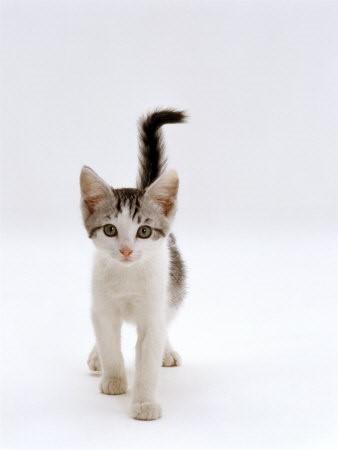
When a cat is relaxed, confident and alert, it walks with its tail horizontally behind it or even slightly drooping. If it meets a friendly cat or friendly human, the tail goes up like a flag-pole to convey its friendliness. If it is friendly but cautious of the other cat or person, the upright tail is hooked over at the tip indicating a degree of uncertainty. A mother cat's upright tail is a signal for her kittens to follow and their upright tails may help littermates or their mother to spot their whereabouts.
When kittens greet their mother, they run to her with their tails upright like small flag-poles. They droop, coil or rub their tails around their mother's butt or tail to ask for food from her. Adult cats also tail-twist. They entwine tails with friendly cats as they rub against each other (the tail has scent from the anal glands on it from where the cat has washed it). They also wrap their tails around human legs or objects. This both marks the leg or object and, if they are tail-wrapping part of the owner, is an attempt to get attention, petting and food!
When a cat is at rest, but readying itself for action, it sweeps its tail erratically from side to side. As it becomes more alert or more emotionally charged, the tail swishes faster, wider and in a more regular manner. If the cat is lying on its side, the tail will be thumping on the floor, often loudly. Though this is most often associated with anger, it may also indicate another highly charged emotion - some cats thrash their tail in ecstasy when being groomed. A swishing or thumping tail is sometimes an invitation for another cat to join in a bout of play. Very few cats wag their tails in happiness like dogs.
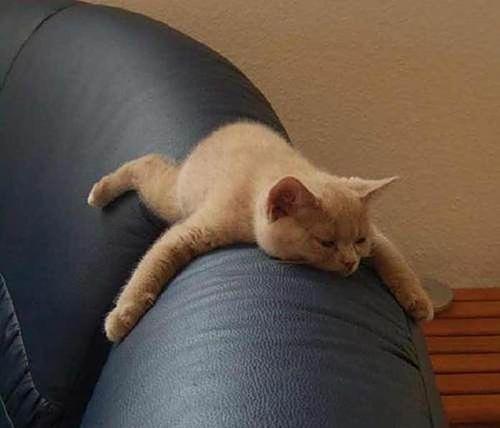
An aggressive cat will straighten its legs (the hind legs are longer than the forelegs, so its rear end will be higher than its shoulders) and erect the hair along its spine and tail into a ridge to make it look more impressive. A defensive cat erects not only a ridge of fur, but all of its fur, puffing itself out. It arches its back and positions itself side-on to its aggressor to make itself look larger still. It wants the attacker to think twice about attacking it. If the attacker pauses, the victim may move sideways in a crab-like fashion (frequently seen in playing kittens); it moves slowly away from its aggressor, watching for any sign of attack. The slow retreat is an attempt to avoid provoking a sudden or instinctive attack.
In contrast, a submissive cat wants to appear small and unthreatening. It may shrink into a crouch indicating that it wants only to be left alone. If this doesn't work, it may sink down on one side demonstrating its submissiveness. If the other cat still threatens, the victim will roll over onto its back, turning its head to face its attacker. This is an appeasement gesture. Unlike the dog, which will go belly-up in full submissive mode, a cat on its back is still a formidable opponent. It has done its utmost to avoid conflict, but if the aggressor continues to press the attack, the victim is able to fight back with all four sets of claws and with teeth. In this position, if the aggressor jumps on its victim, victim's forelegs can clasp the aggressor close to the victim's teeth. Meanwhile, the hind legs are especially dangerous as they may disembowel the other animal.
There are other reasons a cat rolls over. A playful cat will roll over in order to use all four paws, claws sheathed, to "defend" itself, sometimes mock-biting the other cat or the owner. Some cats roll over to greet their owners - this is kitten behaviour and an invite for us to "groom" the cat's belly. Unfortunately the kitten behaviour and the adult behaviour often conflict with each other with painful consequences for the owner. Other cats, those with a great degree of trust and affection, love having their bellies rubbed. The stomach is one of the most vulnerable parts on a cat’s body – thus, when she exposes her stomach to you, this is a playful way of showing her trust in you – and trying to get your attention. If your kitty is able to fall asleep in this position, she trusts you implicitly. Some females roll wantonly in front of males to solicit their attention.
If your kitty nips at your hand while you’re petting her, don’t be offended. Although it may seem a little alarming, this action is simply your kitty’s way of indicating she’s had enough stimulation and she’d like you to leave her be.
However, anyone who has ever had their cat attempt to bathe them by licking their skin will agree – although the gesture is really sweet, it’s also slightly odd. Don’t ask yourself if you need better soap. In reality, cats see grooming another animal as an act of love and caring. When your cat tries to groom you, she’s simply showing that she thinks of you as one big, hairless feline – and she wants to make sure you’re well taken care of.
Does your cat knead your fleshy parts or the pillow you are resting on? Although it seems a bit strange, kneading is a very common behavior in cats. When a kitten is nursing, it uses this same motion to encourage milk to flow from the mother cat. As they age, cats use this same motion to show contentedness.
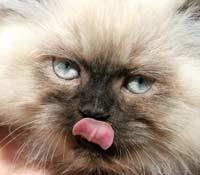
Like kneading, suckling stems from kitty’s nursing days. Cats that suckle frequently typically were weaned from their mother too soon when they were a kitten. If your kitten suckles you or your clothing, she is likely trying to exhibit her love and affection for you.
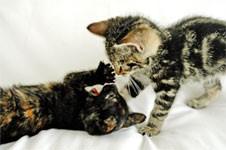
When a cat becomes destructive, the owner is often shocked to hear the professional advice: Get a second cat. The owner's understandable concern is that two cats will do twice as much damage, and the destructive cat will now have another cat to shred. Fortunately, the former is rarely true, mostly because the cat's energy is focused on another cat.
This also seems to make the latter a valid fear. There must be a proper period of introduction, and some hissing and minor scuffles are normal. However, many multiple-cat owners witness normal vigorous feline play and are convinced the cats still aren't getting along. They don’t always realize that when cats are wrestling and tackling each other and bopping each other on the head that they are engaged in play.
Play is an instinctive behavior. All mammals -- including cats, dogs, and people -- play. While play is more frequent and energetic in younger animals, adults play as well. In fact, play persists throughout an animal's lifetime.
Play may well serve as practice for important adult behaviors, which is why so much of it looks like aggression. So when one cat hunkers down, twitches his backside, lashes his tail, and then pounces on his feline roommate, landing full on the unsuspecting victim's back and seizing his neck in his jaws, it's definitely play; the real-life use of that sequence of behavior is stalking and killing prey. But researchers are finally, grudgingly admitting that play could have another purpose, one which humans have known about for time immemorial: It's fun!
Feline play is often no-holds-barred: noisy running, hot pursuit, pouncing, stalking, slamming bodies, wrestling, biting, the works. But in terms of vocalization, it's relatively quiet. An out-and-out catfight would include all the same behaviors as a fun bout of play but with lots of loud hissing, yowling, screaming, and flying fur. Play uses the same behaviors as aggression, but they are inhibited: There are smacks to the head but with claws retracted; bites but with relaxed jaws and exaggerated movements.
Other hallmarks of play include frequent changes in who's the aggressor -- who's on top in the wrestling match, who's chasing whom, or whose body language is more inward or outward -- and the play face (a relaxed, open jaw and wide-open eyes). If you doubt that humans use the play face just watch a bunch of men playing rugby or hockey!
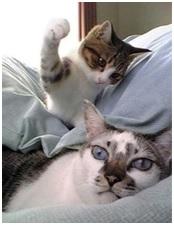
Once that you can recognize play behavior in your cat, you can make him happier and healthier by encouraging it. If there's only one cat in the home, you have the responsibility of being his playmate.
Cat toys are fine as long as they're safe, but your cat also needs you to play with him. Chasing, stalking, and pouncing games are at the top of the feline hit parade. Cats see moving edges better than stationary ones, so toys that wiggle, bounce, roll, or bob are particularly intriguing.
Even in multiple-cat households, the humans need to play with the cats. Play is a kind of "social glue," and the more your cats recognize humans as potential playmates, the better socialized to people they will be.
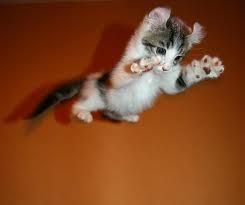
If you have an outdoor cat, you may have had the pleasant experience of having your sweet and valiant cat bring you a bloody prize or two. Although being presented with your kitty’s prize of the day can be extremely gross and alarming, this is simply your feline’s way of showing his reverence for you. Think of it this way: you’ll never starve because you will always have a skilled hunter in your family.
Always be patient with your cat and be consistent with any unwanted behaviour. Remember cats are always trying to communicate whether it is tell you that they want attention, that something is wrong or that they are bored. Listen to what they are saying with body, sounds and eyes and respond accordingly. You will have a happier household as a result.